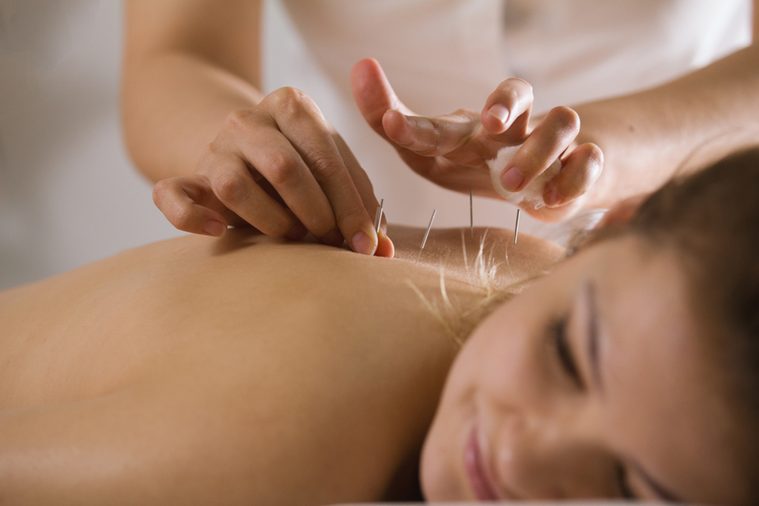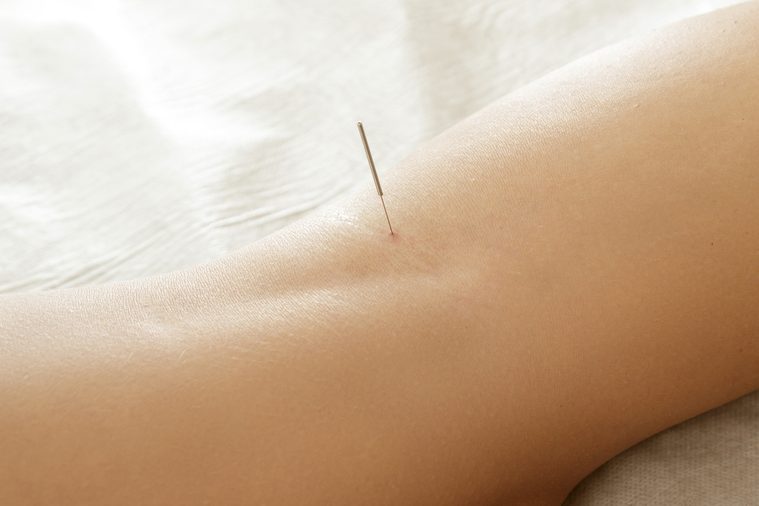What You Need to Know Before Seeing an Acupuncturist
Updated: Jun. 02, 2021
Are you curious about acupuncture? Here’s the inside scoop from experts on what to expect. Two hints: It doesn’t hurt and it could get rid of your wrinkles.
Yes, there are needles—but not the kind you think

Acupuncture needles are nothing like the ones used in a typical doctor’s office. They’re much thinner and flexible—you could fit 40 acupuncture needles into one hypodermic needle. “Often, my patients will not notice the insertion at all, and if they do, the feeling is similar to having an eyebrow plucked,” says licensed acupuncturist Michael L. Fox, PhD, of Silverlake Acupuncture in Los Angeles. FDA regulation requires that each needle is individually wrapped and sterile. Find out more about how exactly acupuncture works its magic in the body.
It works by reestablishing the flow of vital energy
Chinese healers have been using acupuncture for over 2,000 years. Rather than focus on individual symptoms like fatigue or nausea, acupuncturists try to read the flow of vital energy known as “qi” (pronounced “chi”) throughout the body to identify the root cause of the trouble. Acupuncturists believe that there are meridians—pathways—through which qi flows; when health issues arise, it means the pathway is blocked somewhere. “The needle allows you to reach the points where the energy pools; by stimulating that point with the needle, you can open a gate so the energy can flow again,” explains Eugene London, DAOM, a practicing acupuncturist in San Francisco and former chair of the National Certification Commission for Acupuncture and Oriental Medicine (NCCAOM).
Even with the poking, acupuncture is very safe
As long as it’s performed by a licensed practitioner, acupuncture is considered safe. In fact, the chances of complications are far lower than with medications or other medical treatments for the same condition, according to the Cleveland Clinic. There might be slight bruising where the needle goes in, or a bit of muscle ache after the treatment if the area has been overstimulated. Check out these 7 compelling reasons to try acupuncture for weight loss.
Using a certified practitioner is a must
The NCCAOM oversees accreditation for acupuncturists across the country. Its database of licensed acupuncturists is a good place to start your search for treatment. Licensed acupuncturists must complete a minimum of three years in a master’s acupuncture program at an accredited school; those who also practice Chinese herbal medicine must complete a minimum of four years.
It’s great for pain relief
According to the National Health Institute’s National Center for Complementary and Integrative Health, acupuncture offers effective relief for people with back, neck, or knee pain; it can also ease headaches and symptoms of osteoarthritis. “It helps as a nonpharmacologic therapy for chronic pain,” says Ada Stewart, MD, a family physician in Columbia, South Carolina. She points out that acupuncture could be an alternative to highly addictive opioids. “Most of the folks that have gotten it have been pleased,” she says. A recent study published in the Journal of Pain further bolsters the use of acupuncture for lasting pain relief. Read about the 24 things your pain doc won’t tell you.
Acupuncture is used to treat other conditions besides pain
Although studies have mostly focused on acupuncture for pain relief, practitioners have also had success managing sports injuries like tennis elbow and chronic conditions such as infertility, hormonal imbalance, irritable bowel syndrome, fibroids, and seasonal allergies. “We treat long-term chronic diseases rather than acute illnesses like a heart attack,” says acupuncturist Jill Blakeway, MSc, cofounder of Yinova Center, an acupuncture practice in New York. Find out 9 natural treatments for allergies.
Your insurer might cover it
 Acupuncture is an alternative medicine, but more and more insurers, including Aetna, Blue Cross Blue Shield, and United American, cover the treatment for pain management, says Olga Cox at the NCCAOM. Call your insurer to see what it will cover.
Acupuncture is an alternative medicine, but more and more insurers, including Aetna, Blue Cross Blue Shield, and United American, cover the treatment for pain management, says Olga Cox at the NCCAOM. Call your insurer to see what it will cover.
Prepare for strange questions
Your acupuncturist is interested in more than your symptoms. This practitioner is looking for any disharmony in your body that could be causing trouble. So you might be asked whether you prefer hot or cold drinks or if you’re a restless sleeper with vivid dreams. And prepare to stick out your tongue. “You can diagnose a ton from what the tongue looks like, says Blakeway. Note these other ways to treat chronic pain naturally.
You won’t feel rushed
You know how you’re lucky if your doctor spends 10 minutes with you during a visit? This won’t happen with an acupuncturist. The typical visit can run 30 to 50 minutes or more, and your initial visit can be double that so your practitioner can get to know you and diagnose what is causing your symptoms. After that, you’ll go in for one or two sessions a week. How many times you visit the acupuncturist will depend on what’s ailing you; for example, pain-relief treatments can involve three to six sessions.
You can do it in a group setting
If you like the idea of being in an open room full of people also getting acupuncture, consider a communal acupuncture practice. They’re much cheaper: In Florida, for example, a 30-minute private session will run between $80 and $120; a communal session costs just $35 to $60. Check out these 7 surprising conditions that acupuncture can treat.
It might help with aging
While there’s not a lot of research on cosmetic acupuncture, it gets a lot of buzz thanks to its popularity with celebrities like Gwyneth Paltrow. Inserting needles into facial tissue seems to stimulate blood flow to the face, which may boost collagen and elastin production, helping to smooth out wrinkles, fill in fine lines, and give cheeks and jawline more definition, says Shellie Goldstein, LAc, owner of cosmetic acupuncture firm Shellie Goldstein Associates in New York.
It may involve electricity, cups, and herbs
Remember when Michael Phelps had all those red round spots on his back at the Olympics? That was from cupping. An acupuncturist heats cups to create a vacuum and places the cup on the skin over key meridians; the concept is that the suction of the cup increases the flow of qi and helps relieve pain, London says. Sometimes a machine that delivers a tiny amount of voltage may be connected to the needles to help boost qi. Some acupuncturists may also prescribe herbs—the goal, again, is to smooth the flow of qi through meridians. Now read about other alternative medicine treatments that doctors recommend.
